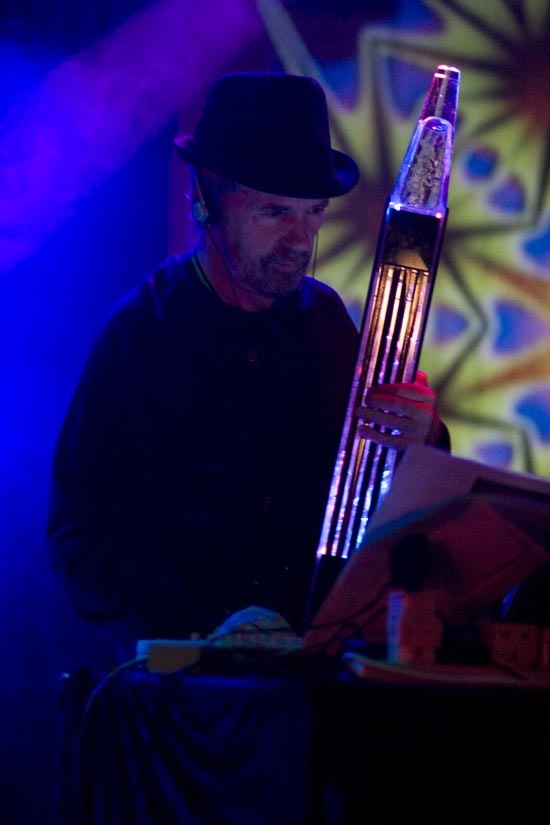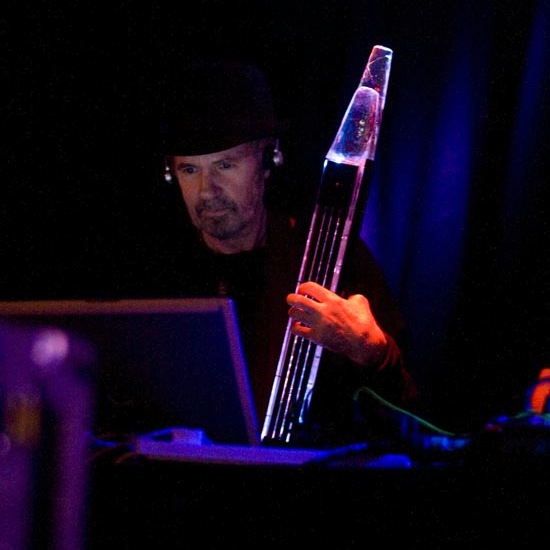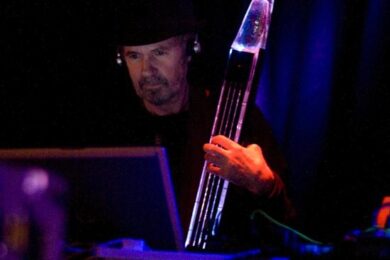Pictures by Stuart Green/Shot2Bits.net
David Vorhaus founded White Noise with the BBC Radiophonic Workshop’s Delia Derbyshire and Brian Hodgson, and they released An Electric Storm in 1969. Despite the colourful blizzards of psychedelic raging across the late-60s pop and rock landscape, electronic music was still considered a novel, unwieldy, impractical and even inauthentic proposition compared to the dominance of the electric guitar; the idea of scissors and magnetic tape as musical instrument, first introduced with musique concrète in the late 1940s, was practically unknown to rock (although ironically The Beatles had had a clumsy stab at the genre with ‘Revolution 9’ on The White Album, to general bemusement). Although the trio only made one album together, it eventually attained the cult status Island boss Chris Blackwell insisted it would. Even in today’s electronically supersaturated pop environment, the spliced sonic juxtapositions of opening track ‘Love Without Sound’ have the power to disconcert the listener as they hove at you from unexpected angles, eerie harbingers of a future where sampling and sound manipulation would become the pop norm.
Vorhaus continued to issue sporadic releases under the White Noise banner, including White Noise II – Concerto For Synthesizer for Virgin in 1975, White Noise III in 1980 and IV and V albums in 1990 and 2000, by which time the ubiquity of ambient and electronic atmosphere made his releases seem rather less like transmissions from the wilderness. Since 2011 he’s been working with fellow sound artist Mike Painter, with whom he’s toured extensively as the duo present their work as a fully realised, spontaneously malleable live spectacle – including this year’s Noise Of Art festival, whose ongoing events also feature Andrew Weatherall and Eat Lights Become Lights.
Although Vorhaus has recently made a contemporary re-recording of ‘Love Without Sound’, it was under a degree of sufferance ("I had to threaten to put him in a bag and beat him with a hosepipe to get him to do it!" says Painter). Vorhaus is very much driven by the agitated, futuristic, anti-retro mindset that impelled him from the late 1960s onwards. This interview took place at his studio in Camden, which features vintage electronic treasures including the first, keyboard-less synthesizer built in Europe and banks of prototype, bespoke sequencer equipment. But these are just for show – Vorhaus swears by the infinite capabilities of modern computer processing rather than the cumbersome devices of yore. He does, however, still brandish a few spectacular innovations of his own…
First off, can you talk a bit about the kaleidophon, the instrument you invented? It seems to combine the merits of a guitar and a synthesizer.
David Vorhaus: It started out as [an instrument] modelled on the bass guitar. It’s got four strings. It’s not a guitar synthesizer, it’s totally different. If you pick it up and try to play it like a guitar, or a bass, you’ll find it very disappointing. For one thing, you’re playing one note at a time, unlike on a guitar. But you can bend notes on it. You can sequence the chords that accompany you.
It does lend a certain theatre to your performances, however – one advantage of the guitar over the synthesizer is that it looks more like you’re wrestling with the instrument, performing honest, authentic work.
DV: Yes, I should learn a few moves. And certainly, synthesizers onstage can look as sexy as if you’re doing your accounts. Tangerine Dream – they had their backs to the audience. What you saw was the gear, these massive stacks of equipment. I remember once realising that what I thought was a Moog wasn’t at all, it was a monitor with an image of a Moog. There’s this element of theatre, though – Mike has a virtual glove which he moves around in space. In the past, my electronics were very much constructed rather than played. I always envied musicians who could just get together and play live but with this new system, that’s exactly what we can do. All the same, it’s very open-ended.
You were very young when you formed White Noise. How did you meet Delia Derybshire and Brian Hodgson?
DV: I was going to play with a symphony orchestra as I did every Tuesday evening, and there was a lecture on electronic music in the hall next door. So naturally I skipped along to that, and I met them and Peter Zinovieff, who were then in a group called Unit Delta Plus. I remembered them from a concert at the Roundhouse. [Delia Derbyshire] taught me everything I knew about electronic music. I was studying electronics at the time, but the idea that they could be used in the context of music was entirely fantastic to me. The pinnacle of one’s career would have been to join the LSO as a bass player. Music was meant to be a hobby. Physics was going to be my career. It was a pure fluke that I should have met them that night and eventually replaced Peter in the group.
Did you consider the possibility that this sort of music could make a pop breakthrough in the late 1960s?
DV: I was just a teenager and pop seemed a very desirable thing – being on TV. I certainly fancied the idea of making an electronic pop record. The first two tracks on An Electric Storm are made up from a recording I made of a friend singing which was then developed in the Radiophonic Workshop. I imagined this would make a hit single. Thank God Chris Blackwell put me right. He said, "Hey, don’t do a hit single, make an album. This could be a cult classic." I thought, I don’t want to be a cult, I want to be a pop star. But I was completely green about that. He also pointed out that the average pop buyer was under 13 years old. Whereas I was in the world of Bartók, Stravinsky and so on – I didn’t really want to be aiming at a market of 12 year olds.
Actually, he didn’t so much convince me as bribe me. He said, "How much money do you think a hit single makes?" And we sat down and worked it out and it came to about £3,000 – about £60,000 in today’s money. So he wrote me a cheque for £3,000 and said, "There, you’ve had your hit single, now go make an album."
Did you feel you had any precedents for putting together an album like An Electric Storm, what with the studio coming into its own with Sgt. Pepper and so on?
DV: Making albums in those days meant people coming in and playing the songs live, essentially, with a few overdubs. Making electronic music meant cutting up tape and splicing every individual note together, monophonically, as a piece of tape, one at a time. How do you do that live? You don’t! Now what I did know about was film-making, so I did know something about assembling things in different places, different times. Once scene at a time became one note at a time. There were a lot of electronic soundmaking devices, but you can do so much with ‘real sound’ – pitch-shifting, bending. It’s much more interesting using those founds sounds than things like sine waves. [He demonstrates on the computer with an extract of a voice, weaving up into a dancing fabric of electronics.] These would have been bits of tape – now, you can digitally store the clips and play them live.
Were you disappointed that the album didn’t make waves commercially at first?
DV: The response when it came out was very disappointing. The record company were worse than useless. Chris Blackwell had been great but he was elsewhere at the time. The record company didn’t have a clue what to do with it and it sold about a couple of hundred copies. So we thought, Well, we got the advance – other than that, it was a waste of time. Then, gradually, it began to get about by word of mouth. It was big on the offshore pirate radio stations – Kenny Everett must have played it 10,000 thousand times.
Do you think it was taken as an uncharted sonic adventure or a soundtrack to drug-taking?
DV: Oh, it was known as the tripper’s album. I can see why. The sounds are very much associated with the psychedelic experience of the time – lots of feedback, very dramatic and frightening moments. I was used to that from making films. It ended up being used in various Hammer Horror films.
Sounds rearing up suddenly from deep space, 3D objects suddenly uncloaking in the dark – it retains its strangeness.
DV: Yeah, but there’s no particular secret or magic box. You just have to do a lot more in your head, figure out what you want and how you’re going to go about getting it. You can make echoes and reverbs by feeding them back onto themselves, taking them down to sub-sonics so you have these massive and very low sounds – you just have to try things out.
Who egged on who – Delia Derbyshire with her Radiophonic Workshop training or you with your outsider’s enthusiasm?
DV: We egged each other on. She showed me the techniques they were using at the Radiophonic Workshop. It seemed magical but it was all obvious when it was demonstrated to you. After a couple of weeks I’d figured out all you need to know technically.
Did she and Brian feel that you were the ‘pop creature’, themselves less so?
DV: Yes, they saw me as the one with pop potential. They were used to working with people like the National Theatre and the Royal Shakespeare Company.
Did they think of pop as low culture?
DV: No, I don’t think that was relevant, really. Brian didn’t see himself as a musician, he saw himself as a sound engineer. He saw himself as a theatrical person and an actor and came to Radiophonics from that perspective. But I don’t think any of them thought that pop was any better or worse than anything else, just different.

Delia and Brian left after An Electric Storm, leaving you as keeper of the White Noise flame. How did you feel about the immediate future both for you and electronic music, moving into the 1970s?
DV: I thought, This music is certainly going to evolve – no one can predict how it will evolve but certainly it will evolve. That felt inevitable. Samplers, for instance, had to be invented, they were so useful. But technically it was a case of suck it and see. One thing that deterred people was that the machinery was so expensive. I’d look at some equipment and it was the same price as I was contemplating paying for a house. Pete Townshend of The Who got himself a synclavier – they were about £250,000 back in the early 70s, so about five or 10 million pounds in today’s money. That’s not like buying a house, it’s more like buying a hotel.
One way in which a lot of electronic music moved into the mainstream in the 1970s was as incidental music – the outro to John Craven’s Newsround was a Radiophonic Workshop creation – or in horror movie soundtracks.
DV: Yes, it’s certainly true that a lot of avant garde classical music works a treat with films, things like Kubrick and 2001: A Space Odyssey. People accept it without thinking. But play it to them in its own right and they’ll be turned off, they’ll say, "Ooh, this is much too highbrow and classical."
So was it difficult to get a hearing when you released the second White Noise album in 1974?
DV: Actually by 1974 it was easy to get a release because by that point An Electric Storm had become quite well-known – in Holland it even got to No 1 in the album chart. There was a chain of record shops with the White Noise logo on the front. So yes, the second album sold 30,000 advance copies before it was even released.
How do you feel listening back to that album now?
DV: A good demo, but a concerto for VCS3s? Forget it! Big mistake. I didn’t know it at the time but the VCS3 wouldn’t be the one and only synthesizer for the next 100 years. Unlike musique concrete, which never became a household standard and never dated, synthesized music did date and VCS3 music did sound dated and naff a few years later.
How would you characterise your more recent work? Terms like ‘dark ambient’ have been bandied about.
DV: I was never particularly interested in genres. It’s very much a genre-led thing these days – handbag house, Essex this that or the other – I don’t give a damn. I try to make good music and let the record companies put it in a slot if they have to. I don’t tend to make slot music.
How interested were you in electronic music contemporaries? Brian Eno, for instance?
DV: Yes, he does have some interesting ideas and is very much an ideas man, rather than someone who I think has particularly made great pieces of music. He was always terrifically energetic – I remember one time him coming in, buzzing about frantically from one bit of equipment to the other saying, "Yes, we must do this, we must do that." Then when he finally sat down to play, it was… [does imitation of an immobile Eno presiding over a lengthy piece of ambient music]
There’s been a longstanding vogue for vintage electronic equipment and a hankering for the pioneering days of analog. Does a part of you ever think it was better for electronic music when it was more difficult to make?
DV: No! I don’t. I know lots of people like that, wanting to buy VCS3s with all the knobs on. No, my god no! I had nothing but that for 10 years! Instruments that wouldn’t stay in tune, and you could only play one note at a time. Thank god for programmes like Reactor, a tool where you can build your own gear on a computer. The potential there is astronomic. I’ve been working on mine for over 10 years. I’ve converted all my old equipment onto my computer. In the old days, we used to go off to places like Amsterdam with a whole car full of gear; one time, we went and we were missing a single module – without which we couldn’t do anything. We literally had to mime to my album. So I thought, Fuck this. Now I’ve built everything into a single laptop. It looks great, all this equipment you see around you, but essentially it’s a museum piece.
Is it gratifying that so many people are harking back to your 60s work, citing you as inspirational?
DV: It is, but what I’m doing now is completely different from what I did then. The important thing is to keep inventing, to keep changing, from the point of view of keeping it interesting. As a musician, it’s important to my sanity. If I go without playing for a long while, I get symptoms of depression. So playing, for me, it’s better than any drug you can take. To feel like you’re still alive and still coming up with new stuff.
So you’re not taken with the feeling of heritage and nostalgia that’s become attached to 21st century electronic music culture?
DV: I don’t want to recreate history, and the whole point is that you can do so much more now. Why on earth go backwards to primitive times when there was a limit to what you could do that was of any interest? Now, you can go so much deeper and further. These are the exciting times.
No one thought electronic music would be so ubiquitous. But there’s always going to really good stuff, as well as really bad stuff and all the stuff in between. About 95% of anything is bad. Including classical music, which is filtered by history. Except for country and western music, and Hawaiian, which are 100% bad.



